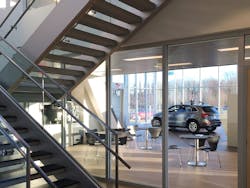This is the time of year to look back on where we’ve been and to look forward to where we need to go. Many years have passed since my days as the “Wired Warrior.” But every year at this time I reflect on just how far the fire-rated glazing industry has come. It’s true that the majority of building owners, architects, and glazing contractors now fully understand the inherent safety hazard of wired glass. We’re even starting to make headway in affecting Canada’s long love affair with this seemingly inexpensive product.
Recognition of the lives that have been shattered and the costly legal settlements that inevitably followed due to a misconception of this product’s impact resistance is finally a reality north of the border. Despite the efforts of myself and many others, there are still door fabricators and glazing contractors willing to skirt the wired glass safety issue and the latest building codes for the sake of saving a buck. Fortunately, all of the major fire-rated glass suppliers now offer a wired glass product that meets federal safety glazing standard CPSC 16 CFR 1201.
However, a false sense of safety still exists when it comes to fire protection strategies in the buildings we occupy. The desire to cut costs fuels the rationalization that balanced fire protection is a needless redundancy. We recently lost an opportunity to furnish passive fire-rated protection in a one-hour corridor for a major renovation project as the result of a contractor’s insistence that there was a cheaper solution. In an effort to maintain the architect’s vision of a glass enclosed corridor, the contractor convinced the owner and architect that adding active protection in the form of sprinklers on both sides of non-rated glazing was far more cost effective than a passive fire-resistive glazing system tested to ASTM E119 as a transparent one-hour wall. The owner was delighted by the prospect of saving money and the architect was satisfied since the original design remained intact. The contractor completed the work. Unfortunately, final construction failed inspection. The building official inevitably accepted the installed solution that included additional sprinklers. However, the water main feeding the building was already at capacity prior to the new construction. The cost of an additional sprinkler system and new water main combined with the added lost use of the building was several times over the cost of our proposed fire-rated assembly fully installed. Unfortunately, this scenario is becoming far too common for both renovation and new construction projects.
“The two-hour rating of this sprinkler/ceramic combination was achieved by ignoring the most crucial aspect of the ASTM E119 test standard being used for reference. Glass ceramic simply doesn’t provide any degree of radiant heat protection. Nor does it qualify for a two-hour rating in anything other than severely limited applications. The debate over the legitimacy of AC385 continues. But despite the NFPA’s most recent citing of sprinkler system effectiveness as being just 87%, with insufficient water being the second most prevalent reason for failure next to the system simply being shut-off, efforts to undermine the strategy of balanced fire-protection continue in the name of cost effectiveness.”
AC385 is the result of an ICC Evaluation Service Report prescribing the use of a specific Tyco sprinkler system initially in conjunction with non-rated glazing for up to two-hours of fire protection. This alternate means of construction subsequently lost ICC approval. AC385 was withdrawn after a great deal of protest from the fire-rated glazing industry and other building professionals. But the report was reinstated after numerous revisions resulting from the input of manufacturers and design professionals on both sides of the issue. Although, the most surprising development was the collaboration of Tyco and Technical Glass Products for joint testing of fire-rated laminated glass ceramic together with the prescribed sprinkler system. On the surface, many would think that this strategy strengthened the level of fire protection as the alternate means of construction equivalency test requires. However, once again a false sense of safety is the real result. The two-hour rating of this sprinkler/ceramic combination was achieved by ignoring the most crucial aspect of the ASTM E119 test standard being used for reference.
This alternate means of construction ignores the requirement for radiant heat protection dictated by the IBC model code. It also flies in the face of the explicit code requirement that fire-rated materials derive their performance rating solely on the basis of inherent material properties tested in conformance with established test standards. Glass ceramic simply doesn’t provide any degree of radiant heat protection. Nor does it qualify for a two-hour rating in anything other than severely limited applications. The debate over the legitimacy of AC385 continues. But despite the NFPA’s most recent citing of sprinkler system effectiveness as being just 87%, with insufficient water being the second most prevalent reason for failure next to the system simply being shut-off, efforts to undermine the strategy of balanced fire-protection continue in the name of cost effectiveness. It’s especially troubling when a major distributor of fire-rated glazing adds to this effort to skimp on safety.
Fire-rated glazing and companion framing assemblies have certainly come a long way since the days of dependence on antiquated wired glass in hollow metal frames. The technology behind fire-resistive glass that provides the highest level of fire protection attainable within the means prescribed by today’s test standards continues to evolve. It will most likely never be as economical as sheetrock and studs. However, its value is derived from the radiant heat protection it provides while adding aesthetic appeal and increased visibility within the surrounding building environment. It’s also a valuable component of sustainable design since it contributes to the expanded use of natural interior daylighting and protects against the needless use of limited resources to reconstruct buildings damaged by fire. This in turn slows the continuing growth of our carbon footprint. Given the many threats we face today, the future requires a greater effort to maintain personal and environmental safety and security by the most effective means possible.
So, as I reflect on the state of the fire-rated glazing industry and the fire protection industry as a whole, I suggest that as building professionals we should ask ourselves whether or not we’re really doing enough to protect one another and the general public within the environments that we construct. As we learned through our experience with wired glass, a false sense of safety is really no safety at all.
About the Author

William O'Keeffe
About the Author: William O’Keeffe is the President and CEO of SAFTI FIRST Fire Rated Glazing Solutions, a leading USA-manufacturer of advanced fire rated glass and framing systems. An industry veteran and innovator with over 45 years of experience in architectural glazing, he was first to introduce and manufacture clear, fire resistive glazing products in the US. He is also a safety advocate who exposed the dangers of traditional wired glass, which lead to code changes and fire rated glass products that are safe, affordable and clear alternatives to traditional wired glass. Today, William continues to develop building products that enable architects to create beautiful, safe and energy-efficient spaces with advanced glazing systems.
